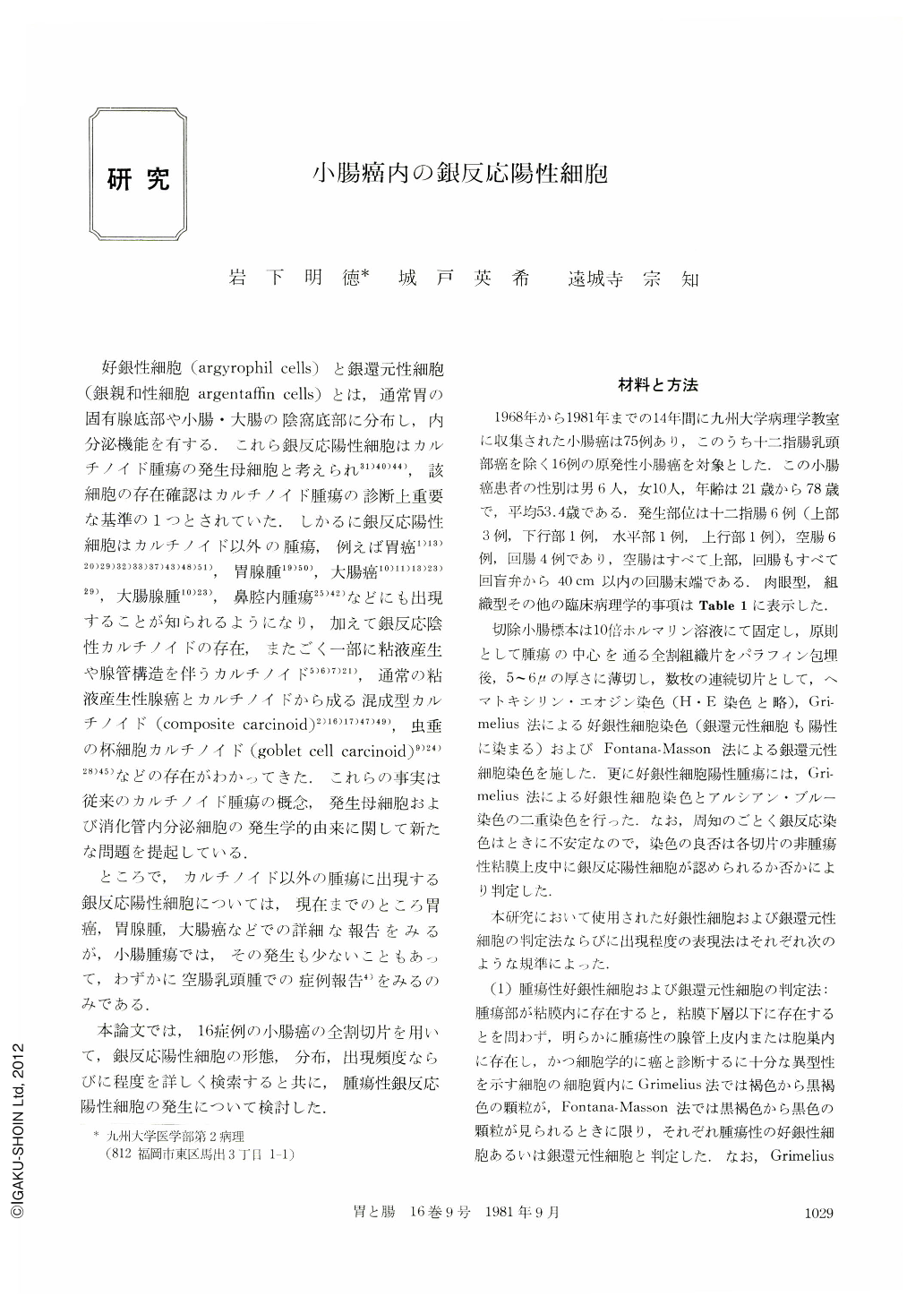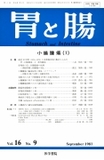Japanese
English
- 有料閲覧
- Abstract 文献概要
- 1ページ目 Look Inside
好銀性細胞(argyrophil cells)と銀還元性細胞(銀親和性細胞 argentaffin cells)とは,通常胃の固有腺底部や小腸・大腸の陰窩底部に分布し,内分泌機能を有する.これら銀反応陽性細胞はカルチノイド腫瘍の発生母細胞と考えられ31)40)44),該細胞の存在確認はカルチノイド腫瘍の診断上重要な基準の1つとされていた.しかるに銀反応陽性細胞はカルチノイド以外の腫瘍,例えば胃癌1)13)20)29)32)33)37)43)48)51),胃腺腫19)50),大腸癌10)11)13)23)29),大腸腺腫10)23),鼻腔内腫瘍25)42)などにも出現することが知られるようになり,加えて銀反応陰性カルチノイドの存在,またごく一部に粘液産生や腺管構造を伴うカルチノイド5)6)7)21),通常の粘液産生性腺癌とカルチノイドから成る混成型カルチノイド(composite carcinoid)2)16)17)47)49),虫垂の杯細胞カルチノイド(goblet cell carcinoid)9)24)28)45)などの存在がわかってきた.これらの事実は従来のカルチノイド腫瘍の概念,発生母細胞および消化管内分泌細胞の発生学的由来に関して新たな問題を提起している.
ところで,カルチノイド以外の腫瘍に出現する銀反応陽性細胞については,現在までのところ胃癌,胃腺腫,大腸癌などでの詳細な報告をみるが,小腸腫瘍では,その発生も少ないこともあって,わずかに空腸乳頭腫での症例報告4)をみるのみである.
Incidence, distribution and morphology of neoplastic argyrophil and argentaffin cells were studied in 16 surgical cases of adenocarcinoma of the small intestine. Whole tissue sections cut through the major axis of each tumor were stained by Grimelius' method for both argyrophil and argentaffin cells and by FontanaMasson method for argentafftn cells. In addition, special preparations were made by combined Grimeliusalcian blue method.
Neoplastic argyrophil and argentaffin cells were found in 11 (68.8%) and seven (43.8%) respectively, of these 16 tumors. Of the positive cases seven contained both argyrophil and argentaffin cells in the same tumor and the number of the former cells was always larger than that of the latter. The argyrophil cells were demonstrated in all of the four tumors of the ileum, in five of the six tumors of the jejunum and in two of the six tumors of the duodenum other than periampullary tumors. The argentaffin cells were also found most often in ileal tumors (75%) and least often in duodenal tumors (16.7%). These cells were recognized only in cases with well differentiated adenocarcinoma, were found almost equally within the tumor tissue by different layers of the intestinal wall, except for the subserosal layer where contained only a few such cells invariably, and were present even in metastatic sites. Distribution of these cells within the tumor tissue was usually focal, though diffuse in two tumors. These cells were flask-like or cylindrical in shape and the characteristic brown to black granules were commonly situated in the infranuclear cytoplasm. Out of 11 tumors double-stained by the Grimeliusalcian blue method, none contained any cells having both argyrophil granules and mucus together.
Argyrophil and argentaffin cells within the tumor tissue are assumed to be integral components of the tumors and to have arisen by divergent differentiation of the more primitive neoplastic cells. It is indicated that a true carcinoid tumor belongs both basically and clinicopathologically to a different category from carcinomas with argyrophil and/or argentaffin cells in discussion.

Copyright © 1981, Igaku-Shoin Ltd. All rights reserved.


